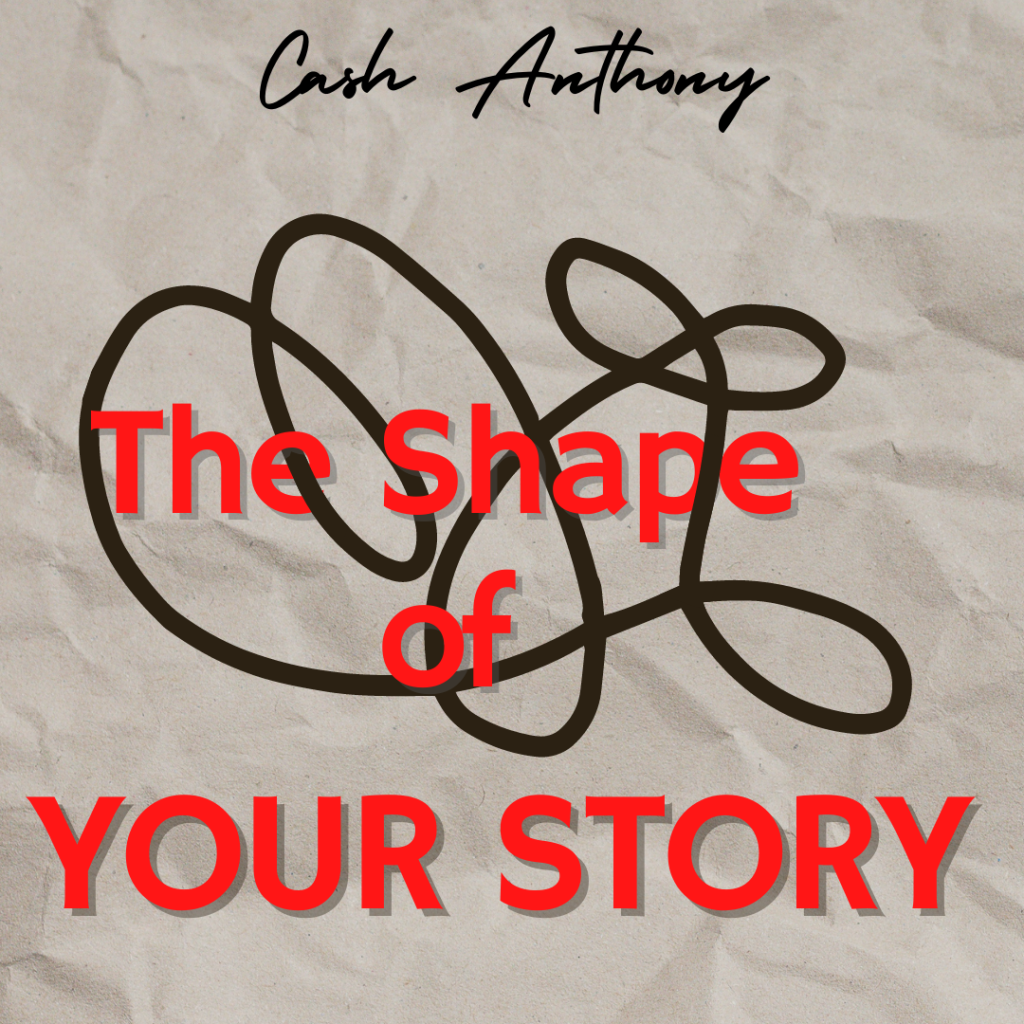
A writer sits at the keyboard with a great idea for a story. The characters live in his imagination. The world of the story has become clear. The opening hook is perfect. The core narrative’s basic conflict has been decided, though the sequences of action may not be fully in mind; but the writer knows how it’s going to end, and he’s certain that the part in the middle will spring onto the page as his fingers move and the words appear, phrase by phrase, sentence by sentence. He may even have put together an outline to guide him.
The one thing that he may not have created is—a doodle.
A simple doodle, a drawing that represents the story, is a tool most writers haven’t been taught to use. The most common story shape doesn’t need it—that’s why drawing it may sound ridiculous. A story that progresses in a straight line is easy enough to envision. Putting a vertical line, or a horizontal line if you prefer, on paper to connect A to B to C (by causality) isn’t especially valuable.
But stories don’t have to be told like that. A simple doodle is one way to get out of the box, to open the writer’s mind so that a reader has a unique, entertaining experience on this particular journey through fictional time.
What other shape might a story take, if it’s not told in a straight line? Here are a few. It might be a spiral. It might be a circle. It could be a series of boxes, each one attached to the previous one and getting bigger or smaller as they go. It could be a number of boxes inside each other like Russian Matryoshka dolls. Concentric circles would have that same shape. It could start on a flat plain and rise to a mountain peak before it suddenly falls, dropping precipitously back to where it began. It could be crenelated, like the wall of an ancient castle, with segments that are high alternating with ones that are lower, the highs contrasting with the lower again and again. It could look like a spoon falling into a dish of pudding! Yes, the story starts when the spoon hits the surface and ends when the bowl has been scraped clean. Turn the dish of pudding on its side, and it becomes a locked door. The main character runs into it full tilt and falls flat. Now he must seek another way past it. The straight line might have branches that split off and then meet again to continue in a single line. The circle might have smaller circles that grow out of it with each one fixed at its base, like petals on a daisy.
Really? Yes, these are all available to a writer. Let’s see what each one has to offer to enlarge the writer’s mental constructs before he starts writing.
The spiral: the story starts on the outer edge, at a distance from the central conflict. The main character identifies and responds to the essential problem without solving it. But it arises at more and more frequent intervals, with greater severity and increased tension. Each time around, that pattern is emphasized more. Hamlet’s obsessive self-doubt grows with each setback, each failure to act until he succumbs characteristically to the tragic circumstances of his life.
The circle: the main character starts out on a journey, meets obstacles and opportunities as he goes, experiences a kind of ultimate test or brush with death, and comes back to the starting point—changed in some essential way, yes, but victorious. He brings the lessons he’s learned home to the waiting community he left. This is the basic warrior’s story—the hero’s journey.
The progressively larger or smaller boxes: the main character struggles to escape from one “locked room” of problems but immediately finds himself in another one in a different environment. The way he succeeded in the previous one provides clues about what he must do in the next one, but the problems are not the same. One early computer game, Myst, was designed this way.
The mountain climb: the first part of the story shows the main character’s weaknesses or flaws, but at each stage of higher tension, those characteristics turn out to be assets until he reaches the highest peak. These stories rarely end positively, though—they often end with a great fall back to the starting point. Many TV series are designed this way so that by the last episode, it becomes obvious that nothing’s really changed.
The concentric circles: the main character meets someone who once faced the same problem and who tells his own story of how he solved it, based on a story he was told by someone else who had faced that same problem, and so on. A story-within-a-story structure, these embedded tales center around the same idea or theme. The Canterbury Tales and Watership Down are examples of this.
The crenelated wall: one thought is presented, followed by its contrast. Then a second idea is introduced and contrasted with its opposite. A series of these proposals takes the reader’s emotions from low to high, from despair to hope, again and again. The “I Have a Dream” speech of Martin Luther King, Jr. illustrates how this works.
The bowl of pudding: the narrative starts when a problem or opportunity is dropped into the ordinary world of the main character “out of the blue.” From that point on, he must swim out of the situation until he reaches a safe harbor or perishes. The story of the disaster on Mount McKinley in 1967 is an example, told most recently in Denali’s Howl: The Deadliest Climbing Disaster on America’s Wildest Peak. This is sometimes called in media res (in the middle of things).[A college student invites unrelated mountain climbers to undertake the ascent of the country’s highest mountain with him. Six men accept, believing they have adequate experience and equipment. They begin the ascent expecting clear weather throughout the expedition, but most start to suffer from altitude sickness, which leads them to make poor decisions. They split up into smaller groups trying to climb to the peak, some succeeding, others turning back. They lose contact with each other. Then a blizzard hits, and descent is impossible in the whiteout. Winds near the summit were later estimated to have reached 300 mph…and they all freeze to death. The remains of only three were located the next year, but they were left because no equipment existed to bring them down. Eventually, an attempt was made to find them and bury them, but by then they had disappeared. None of the seven climbers’ remains were ever recovered.]
The straight line with branches that join the line again: a straight-line story doesn’t have to stay straight. Middle branches that go off in different directions represent a problem with several potential solutions. All the characters try to find their own at the same time, then re-assemble and decide on a path forward. The story of Steve Jobs’ role at Apple is an example of this. By the time he’d been fired and returned to Apple to become its CEO, he knew the value of collaboration, but he personally determined the company’s direction with complete confidence. He focused on what he was good at while team members like Tim Cook took the then-current problem to their own divisions. When they had worked out their separate solutions, they met again and synthesized what they had learned.
The line that smacks into a door: Actors and singers, athletes and writers—among others—know what it’s like to start in one direction and run into an insurmountable problem. Instead of beating their heads against a locked door, they back up and study the problem from another angle, then figure out how to go around it. They may decide that getting through that door isn’t even desirable anymore, because the path they really want to follow is a different one altogether, or they may find a parallel path that takes them to the same destination. In story terms, this is sometimes called a “false start.” It gets the audience’s attention quickly and goes in a seemingly predictable direction, but suddenly their expectations are disrupted. The challenge to their sense of security keeps them engaged to see what’s going to happen next. F. Scott Fitzgerald wrote One Hundred False Starts about his own process of creating fiction. Your characters may find themselves in the same situation.
The flower petal: Here, a series of mini-stories or scenarios are each complete in themselves but end with the same conclusion. They have multiple characters who meet similar obstacles and challenges, but each story is told to the end before another one starts. (The “petals” may overlap by having one story introduce the next.) This is useful if several stories are unconnected but relate to the same theme. This gives weight to the theme by repeatedly showing how important it is.
If the writer intends only to produce a short story, the straight-line method may be the most efficient technique to use, as the opportunity to choose a different shape may not arise in that format. But before starting a longer work, drawing a doodle can help you decide the best way to write it—and serves as a reminder if the story begins to go off-track.
Visualizing these ten classic storytelling shapes is one technique that can spur a writer’s creativity. Many resources are available online to show how to use each one.

